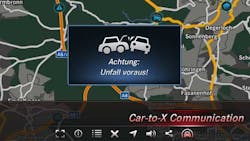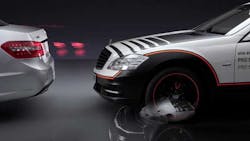Tomorrow’s Car Will See Around Corners And Have Outside Airbags
You’re driving up a hill and immediately over the crest is a stationary tailback of traffic. You won’t know about it, but your car will. It also will warn you and automatically implement actions to stop you from piling into the back of the queue. And if you can’t avoid a collision, exterior airbags will mitigate the damage.
Headed by Daimler, these futuristic automotive developments and others are being trialed in Germany, and they could become a reality within seven years.
The simTD (Safe Intelligent Mobility – Test-field Deutschland) research project uses wireless technology based on the conventional wireless local-area networking (WLAN) standard and integrates Universal Mobile Telecommunications System (UMTS) and GPRS mobile technologies to enable any vehicle to create and transmit road traffic information.
Called Car-to-X communication, it is expected to greatly expand a vehicle’s visual field, or “telematic horizon” as the experts call it. This will happen because cars will be able to communicate with each other and with fixed traffic transmission stations.
The system will “see” ahead and warn the driver about obscured and stationary traffic and unseen dangers like black ice. It also will tell drivers if there are more vehicles in front of the truck you are considering passing. In addition to these safety-related applications, convenient functions such as suggested routes to the next free parking space could be implemented.
How Will It Work?
Car-to-X communication links vehicles and infrastructure in an electronic network. Information then can be exchanged between different vehicles as well as between vehicles and traffic communication infrastructures, such as variable message signs and traffic lights (Fig. 1).
The radio technology developed for the system is based on the established WLAN standard. Each simTD vehicle uses its onboard sensors to detect traffic events. The intelligent traffic system (ITS) Vehicle Station (your car) communicates this information to other vehicles and to the ITS Roadside Stations, the roadside equivalent to the vehicle’s onboard system. The vehicle also keeps its driver informed and issues visual and auditory warnings when appropriate.
The simTD vehicle system can use mobile phone technologies such as UMTS to transmit Car-to-X messages as well, bridging any communication gaps in the network. WLAN-based and cellular radio communications have been successful in field trials where information was shared between vehicles and traffic information stations.
A fleet of 120 vehicles and three motorcycles equipped with the technology has successfully completed a 41,000-hour and 1,650,000-kilometer field trial. The main goal of the simTD field test was to prove the practical viability of the system. The scientists proved that under realistic user conditions, Car-to-X communication between vehicles, the ITS Roadside Stations, and the ITS Central Stations works.
In addition to the economic savings from reducing the number of accidents, there is an ecological advantage. Traffic flows would be improved, cutting carbon-dioxide emissions as well.
Airbags On The Outside
The future car also could feature airbags on its exterior in addition to the interior ones we already use. Although these exterior airbags would have very different functions, the overall aim is to improve occupant safety.
The concept of these airbags is not new, and they resemble those that have been used to slow fighter aircraft landing on aircraft carriers. In addition to the vehicle’s normal braking, a parachute is deployed to increase vehicle deceleration.
A newer idea has been designed into a Mercedes experimental vehicle, fitting an airbag under the front of the vehicle. A sensor system that scans the forward path of the vehicle indicates that a collision is possible. It then activates the brakes and deploys the airbag (Fig. 2).
The airbag serves two purposes. First, it adds to vehicle deceleration because of the drag factor. Second, it keeps the vehicle level, which is particularly important. While braking, the front of a car dips down. But the under-car airbag raises the front end and improves geometric compatibility with the oncoming vehicle.
In effect, the braking airbag enhances the crumple zone. Mercedes engineers have calculated that even at a low speed of 50 kph, the additional deceleration has the same effect as lengthening the front end by 180 mm, creating additional energy absorption ability.
Preventing the vehicle’s nose from dipping under braking also improves the effects of the seat head-restraint systems and allows seat-belt tensioners to operate more efficiently.
About the Author
Paul Whytock Blog
European Editor
Paul Whytock is European Editor for Penton Media's Electronics Division. From his base in London, England, he covers press conferences and industry events throughout the EU for Penton publications and its Engineering TV and Radio services Qualified to HNC Full Technological Certificate standard, Whytock trained as an automotive design engineer with Ford Motor Company prior to entering technical journalism.


